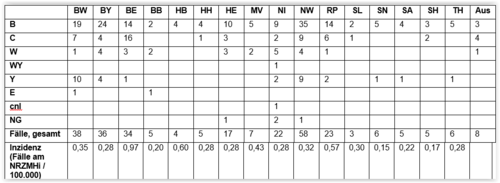Daten 2016 (eng)
Data on the laboratory-based surveillance of meningococci (2016)
Introduction
The German National Reference Centre for Meningococci and Haemophilus influenzae (NRZMHi) is assigned by the Robert Koch Institute (RKI) with the performance of laboratory based surveillance of invasive meningococcal disease (IMD). In 2016, 454 samples from 375 individuals were analyzed. The NRZMHi confirmed Neisseria meningitidis in 302 patients, in 282 of them from primarily sterile compartments (latter figure corresponds to the number of cases with invasive disease). In 36 patients (out of 282) detection of meningococci was carried out using molecular techniques only. During the same period 339 cases of IMD were notified to the RKI (data as of 21.03.2017, SurvStat@RKI). These figures reflect a small increase of the incidence rate for IMD from 0.36/100,000 in 2015 to 0.41/100,000 in 2016. Given that all processed cases of IMD were notified retrospectively, one can assume an 83% coverage of IMD by NRZMHi (86% in 2015).
Frequency of serogroups B, C, W and Y (2016)
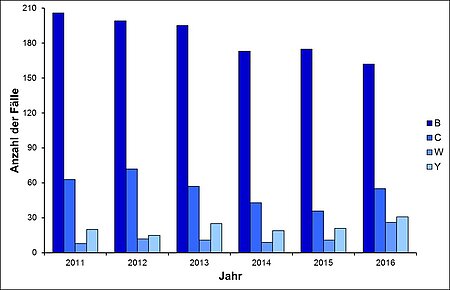
The number of serogroup B cases continued to decrease, while an increase of serogroups C, W and Y cases was observed.
Serogroups according to age groups (2016)
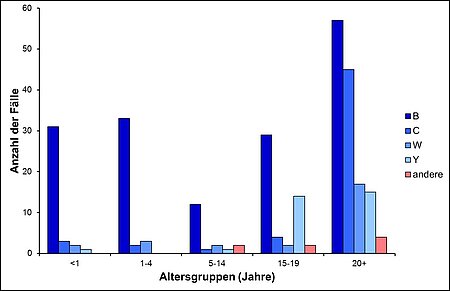
The majority of serogroup C and Y cases occurred in patients aged 20 years or more.
Serogroups according to federal states (2016)
BW: Baden-Wuerttemberg, BY: Bavaria, BE: Berlin, BB: Brandenburg, HB: Bremen, HH: Hamburg, HE: Hesse,
MV: Mecklenburg-Western Pomerania, NI: Lower Saxony, NW: North Rhine-Westphalia, RP: Rhineland-Palatinate,
SL: Saarland, SN: Saxony, ST: Saxony-Anhalt, SH: Schleswig-Holstein, TH: Thuringia, abr: abroad.
In four cases, the serogroup could not be determined (NG). In eight cases, disease onset was in Germany, but patients were visitors from abroad.
Geographic distribution of serogroups (2016)
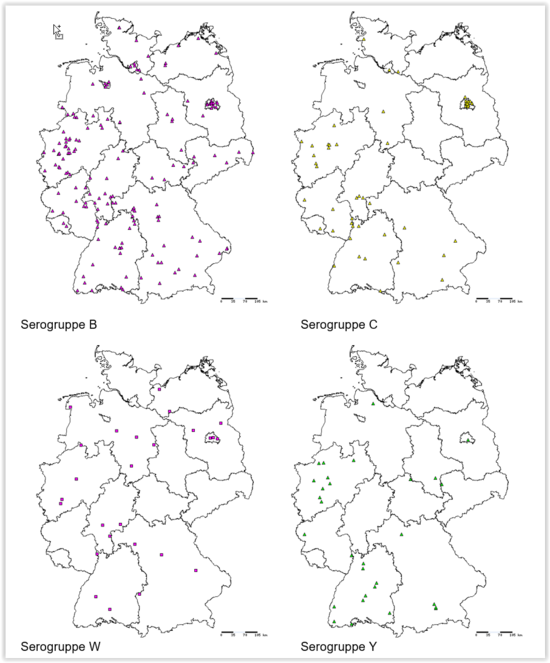
The coloured symbols represent cases with the respective serogroups.
Serogroup Y predominated in Baden-Wuerttemberg and North Rhine-Westphalia.
All maps were generated with EpiScanGIS.
Most common finetypes (2016)
Finetype | Number of Cases | % of cases |
B:P1.7-2,4:F1-5 | 20 | 7,0 |
B:P1.22,14:F5-5 | 17 | 6,0 |
Y:P1.5-2,10-1:F4-1 | 14 | 4,9 |
B:P1.22,14:F5-1 | 13 | 4,6 |
C:P1.5,2:F3-3 | 10 | 3,5 |
C:P1.18-1,3:F5-8 | 9 | 3,2 |
W:P1.5,2:F1-1 | 9 | 3,2 |
B:P1.7-2,4:F5-1 | 8 | 2,8 |
C:P1.5-1,10-8:F3-6 | 8 | 2,8 |
Y:P1.5-1,2-2:F5-8 | 7 | 2,5 |
B:P1.18-1,3:F1-5 | 6 | 2,1 |
In 2016, a total of 115 different serogroup-PorA-FetA combinations (finetypes) were observed
Most common finetypes according to age groups (2016)
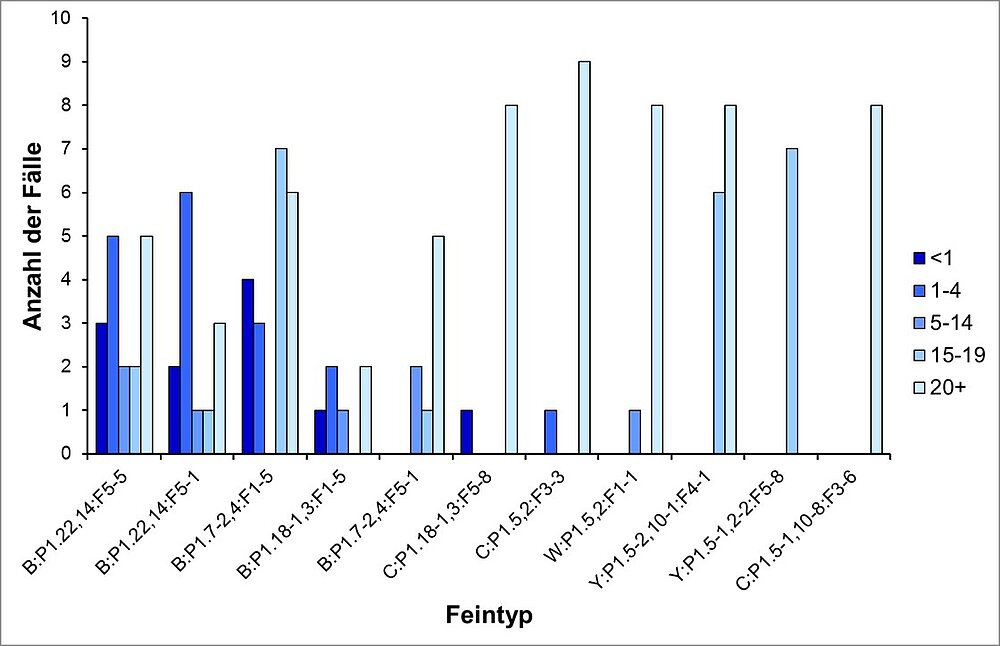
Some finetypes occurred predominantly in patients aged 20 years or more.
Antibiotic susceptibility of invasive isolates
(according to EUCAST 2016)
Antibiotikum | sensibel | intermediär | resistent |
Penicillin | 149 | 75 (31,3%) | 16 (6,7) |
Cefotaxim | 240 |
|
|
Ciprofloxacin | 235 |
| 5 |
Rifampicin | 239 |
| 1 |
The proportion of penicillin intermediate susceptible and resistant isolates increased from 12.8% and 1%, respectively, in 2015 to 31.3% and 6.7%, respectively, in 2016.
Disclaimer
The above data were generated with federal funds (RKI). Scientific use is prohibited without prior written consent by NRZMHi or RKI. Commercial use is strictly prohibited. Inclusion of figures or tables in talks or oral presentations is not allowed.
© NRZMHi 2016

